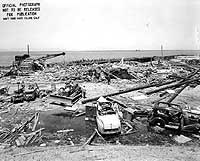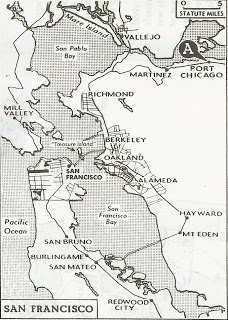Sarah Sundin's Blog, page 501
October 24, 2011
Today in World War II History
70 Years Ago—Oct. 24, 1941: Germans take Kharkov and Belgorod.
Published on October 24, 2011 03:00
October 23, 2011
Today in World War II History
70 Years Ago—Oct. 23, 1941: DeGaulle asks French resistance to stop murdering Nazis, to prevent reprisals. 23,000 Jews in Odessa massacred in reprisal for death of Gen. Glugoscianu. German Jews forbidden to leave country.
Published on October 23, 2011 03:00
October 22, 2011
Today in World War II History
70 Years Ago—Oct. 22, 1941: Nazis kill 50 civilian hostages in Nantes in reprisal for assassination of Col. Karl Holz, commander of Nantes. Gen. Glugoscianu, Romanian commander of Odessa, killed by bomb left by Soviets.
Published on October 22, 2011 03:00
October 21, 2011
Today in World War II History
70 Years Ago—Oct. 21, 1941: Nazis vow to kill 100 hostages for every German killed in occupied countries. Germans massacre Serbs—7000 in Kraljevo, 6000 in Macvo. Pan Am begins DC-3 military air transport services to Egypt.
Published on October 21, 2011 03:00
October 20, 2011
A Solemn Responsibility
 When I became a pharmacist, I was struck by the realization that I held other people's lives in my hands. If I enter the prescription into the computer for the wrong patient, select the wrong medication or strength from the shelf, fail to recognize a drug interaction, calculate the wrong dose, or commit any number of possible errors, the patient can be harmed. Whoa. I treat my work in pharmacy as a solemn responsibility requiring wisdom. When Abraham told his chief servant, most likely Eliezer of Damascus, to find a wife for his son Isaac, Eliezer must have felt that same sense of responsibility. Isaac was Abraham's beloved son, the child of the covenant, through whom God had promised to bless all nations. Not just any wife would do. The woman would be the mother of nations. She had to be pleasing to Abraham, to Isaac, and most importantly, to the Lord. Eliezer had to get it right.So Eliezer prayed for wisdom. Only the Lord knew the right woman, and Eliezer prayed for God to reveal her to him. God did so. Eliezer was thrilled. Abraham was thrilled. And Isaac fell in love.James 1:5 says, "If any of you lacks wisdom, he should ask God, who gives generously to all without finding fault, and it will be given to him." This is one prayer the Lord never refuses. Whatever solemn responsibility lies before you, know God will give you the wisdom to handle it. All you have to do is ask.
When I became a pharmacist, I was struck by the realization that I held other people's lives in my hands. If I enter the prescription into the computer for the wrong patient, select the wrong medication or strength from the shelf, fail to recognize a drug interaction, calculate the wrong dose, or commit any number of possible errors, the patient can be harmed. Whoa. I treat my work in pharmacy as a solemn responsibility requiring wisdom. When Abraham told his chief servant, most likely Eliezer of Damascus, to find a wife for his son Isaac, Eliezer must have felt that same sense of responsibility. Isaac was Abraham's beloved son, the child of the covenant, through whom God had promised to bless all nations. Not just any wife would do. The woman would be the mother of nations. She had to be pleasing to Abraham, to Isaac, and most importantly, to the Lord. Eliezer had to get it right.So Eliezer prayed for wisdom. Only the Lord knew the right woman, and Eliezer prayed for God to reveal her to him. God did so. Eliezer was thrilled. Abraham was thrilled. And Isaac fell in love.James 1:5 says, "If any of you lacks wisdom, he should ask God, who gives generously to all without finding fault, and it will be given to him." This is one prayer the Lord never refuses. Whatever solemn responsibility lies before you, know God will give you the wisdom to handle it. All you have to do is ask.
Published on October 20, 2011 05:00
Today in World War II History
70 Years Ago—Oct. 20, 1941: Carrier USS Hornet (CV-8) commissioned under Capt. Marc Mitscher. Germans massacre 2300 Serbs in Kragujevac.
Published on October 20, 2011 03:00
October 19, 2011
Today in World War II History
70 Years Ago—Oct. 19, 1941: Stalin announces he'll stay in Moscow; declares a state of siege.
Published on October 19, 2011 03:00
October 18, 2011
Today in World War II History
70 Years Ago—Oct. 18, 1941: Gen. Hideki Tojo becomes Prime Minister of Japan, forms military government. New movie: Target for Tonight, an RAF documentary of a bombing raid on Germany. Movie premiere of The Maltese Falcon, starring Humphrey Bogart & Mary Astor.
Published on October 18, 2011 03:00
October 17, 2011
Port Chicago - the Work Stoppage
 In the worst Home Front disaster of World War II, an explosion at the Naval Magazine in Port Chicago, California on July 17, 1944 killed 320 men, of whom 202 were black. The tragedy was followed by a work stoppage and a controversial mutiny trial. This sent ripples of change through the segregated armed forces.
In the worst Home Front disaster of World War II, an explosion at the Naval Magazine in Port Chicago, California on July 17, 1944 killed 320 men, of whom 202 were black. The tragedy was followed by a work stoppage and a controversial mutiny trial. This sent ripples of change through the segregated armed forces. These events are included in my third novel, Blue Skies Tomorrow. Previous blog posts discussed the situation in the armed forces and at Port Chicago, and the explosion, today I'll cover the work stoppage, and over the next couple of weeks we'll look at the trial, and the aftermath.
Survivors
After the July 17, 1944 explosion claimed 320 lives, most of the survivors were taken to Port Shoemaker in Oakland. However, two hundred men remained to help in the grisly clean up. By the end of the month, reconstruction began, and the first berth on the new pier opened September 6, 1944. Survivors' leaves were granted to the white, but not the black survivors.
Congress met to decide on payments to beneficiaries, usually $5000. However, when Senator John Rankin (D-Mississippi) heard most of the beneficiaries were black, he demanded lowering payments to $2000. Congress settled on the insulting amount of $3000, which applied to white beneficiaries as well.
Since the war continued and the Navy's need for ammunitions in the Pacific had not diminished, three of the surviving work divisions (all black) from Port Chicago were sent to the main depot across the river at Mare Island in Vallejo.
 Work Stoppage
Work StoppageThe men remained jittery from the explosion that had killed so many of their friends. No new training was given, no new safeguards were instituted, and the men served under the same white officers from Port Chicago. Tensions rose as they realized they'd be asked to load ammunition again. They knew firsthand the hollowness of the promise that the ammunition couldn't detonate.
On August 9, 1944, the men were marched from their barracks at Mare Island toward the dock to load ammunition again for the first time since the explosion. Suddenly, the men stopped marching. They said they were afraid to handle munitions and they'd obey any order except the order to load ammunition.
Upon further questioning from the officers, of the 328 men in the three divisions, 258 refused to work. These men were confined to a barge, since the brig wasn't big enough. For three days, the men remained under guard on the crowded, poorly ventilated barge.
The Admiral's Demand
On August 11, the 258 men were gathered on the baseball field. Admiral Carleton Wright, commander of the 12th Naval District, addressed the men. He informed them that refusing to work in time of war was mutinous behavior, and that mutiny carried the death penalty.
The men were asked again if they were willing to work, and 208 said they were willing, but the remaining 50 refused and were taken to the brig at Camp Shoemaker in Oakland, California. These 50 men included two who refused because they were mess cooks and had never handled munitions before—one had a nervous condition and the other was underweight. Another man refused to work due to a broken wrist in a cast.
Interrogations
All 258 of the men who initially refused to work were interrogated at Camp Shoemaker, under armed guard and without counsel. The transcripts of their testimonies were often wildly inaccurate, but they were given no choice but to sign the testimonies.
On September 2, President Roosevelt recommended that the 208 men who agreed to return to work receive light sentences. These 208 were given Summary Courts Martial and bad-conduct discharges, and were docked three months' pay. The 50 men who refused to work were given General Courts Martial with the charge of mutiny.
Sources:
Allen, Robert L. The Port Chicago Mutiny. Berkeley CA: Heyday Books, 2006.
War Time History of U.S. Naval Magazine, Port Chicago, California. Washington DC: US Navy Bureau of Ordnance, 5 December 1945. On Naval Historical Center website. Accessed 2 October 2011. http://www.history.navy.mil/faqs/faq80-3d.htm
Published on October 17, 2011 05:00
Today in World War II History
70 Years Ago—Oct. 17, 1941: Destroyer USS Kearney torpedoed protecting convoy; first US casualties of the war—11 killed, 2 wounded. US Army Air Force establishes Air Service Command (supply and maintenance) under Brig. Gen. Henry Miller at Wright Field OH.
Published on October 17, 2011 03:00



